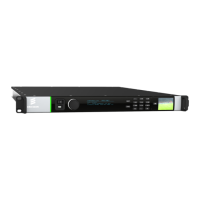Web GUI Control
Table 5.119 Column FEC
Overhead (L + (D x L)) / (D x L) = 1 / D + 1
Worst case 4 rows = 25%
Best case 20 rows = 5%
Table 5.120 Column and Row FEC
Overhead (L + (D x L)) / (D x L) = 1 / D + 1
Worst case 4 rows = 25%
Best case 20 rows = 5%
Block Alignment
FEC offers two methods of block alignment (also referred to as FEC linearisation)
for use when generating FEC packets: Non Block Aligned and Block Aligned. Both
are guaranteed of being able to correct L errors, sometimes more. The Block
Aligned method can however correct 2L+2 errors; this never happens with Non-
Block Aligned.
Non-Block Aligned can in theory have a lower latency at the decoder if it can be
guaranteed that the mode of operation will never change.
Block Aligned linearization is dealt with in Annex B of the ProMPEG Code of
Practice. In Block Aligned column FEC packets are sent every D’th frame and the L
Column FEC packets are played out every D slot. They are therefore evenly spread
over the D*L matrix period.
Non Block Aligned linearization is dealt with in Annex A of the ProMPEG Code of
Practice. In Non Block Aligned the matrix is ‘skewed’ for the column calculation. The
L column FEC packets are played out at the end of every column plus a constant.
For ‘square’ matrices (diamonds) where L = D then these column packets will
emerge at regular intervals. For ‘rectangular’ diamonds they will not. In the case of a
4 column by 20 row matrix the 4 FEC packets will emerge within 16 slots, followed
by a gap of 64 slots before the next 4. It therefore produces a less linear spread of
packets.
Receivers which do not have FEC capability can simply ignore the FEC packets and
just make use of the media packets.
5.5.4.5 VLAN Tagging
VLAN tagging can be used to segregate IP packets from data interfaces.
5.5.4.5.1 VLAN Creation
A VLAN is created by specifying the VLAN ID, IP address and the Netmask. All
Transport Streams which are tagged to this VLAN use the VLAN IP address as its
source IP address. Hence the VLAN and VLAN ID must be created before it can be
used to tag a Transport Stream.

